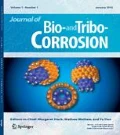Abstract
Ti–Cu alloy has shown potential biomedical application due to its high strength, good corrosion resistance, good machinability, good biocompatibility and strong antibacterial properties. In this paper, the tribocorrosion behavior of Ti–Cu was investigated in comparison with commercial pure Ti. Tribocorrosion tests were carried out against silicon nitride sphere, with open-circuit potential (OCP) wear condition and potentiodynamic wear condition. OCP and coefficient of friction were recorded during the sliding process. The worn surface was observed by scanning electron microscopy, and the worn profile was scanned to calculate the weight loss. The results have indicated that Ti–Cu exhibited better tribocorrosion properties than cp-Ti, abrasion being the main wear mechanism.



References
Manam NS, Harun WSW, Shri DNA, Ghani SAC, Kurniawan T, Ismail MH, Ibrahim MHI (2017) Study of corrosion in biocompatible metals for implants: a review. J Alloys Compd 701:698–715
Zhang E, Ren J, Li S, Yang L, Qin G (2016) Optimization of mechanical properties, biocorrosion properties and antibacterial properties of as-cast Ti–Cu alloys. Biomed Mater 11:065001
Yao X, Sun QY, Xiao L, Sun J (2009) Effect of Ti2Cu precipitates on mechanical behavior of Ti–2.5Cu alloy subjected to different heat treatments. J Alloys Compd 484:196–202
Kikuchi M, Takada Y, Kiyosue S, Yoda M, Woldu M, Cai Z, Okuno O, Okabe T (2003) Mechanical properties and microstructures of Ti–Cu alloys. Dent Mater 19:174–181
Takahashi M, Kikuchi M, Takada Y (2002) Mechanical properties and microstructures of dental cast Ti–Ag and Ti–Cu alloys. Dent Mater J 21:270–280
Bao M, Liu Y, Wang X, Yang L, Li S, Ren J, Qin G, Zhang E (2018) Optimization of mechanical properties, biocorrosion properties and antibacterial properties of wrought Ti-3Cu alloy by heat treatment. Bioact Meter 3:28–38
Zhang E, Wang X, Chen M, Hou B (2016) Effect of the existing form of Cu element on the mechanical properties, bio-corrosion and antibacterial properties of Ti-Cu alloys for biomedical application. Mater Sci Eng C 69:1210–1221
Ren L, Ma Z, Li M, Zhang Y, Liu W, Liao Z, Yang K (2014) Antibacterial properties of Ti–6Al–4V–xCu alloys. J Mater Sci Technol 30:699–705
Marcinak C, Young F, Spector M (1980) Biocompatibility of a new Ti-Cu dental casting alloy. J Dental Res 59:47
Bai B, Zhang E, Dong H, Liu J (2015) Biocompatibility of antibacterial Ti–Cu sintered alloy: in vivo bone response. J Mater Sci Mater Med 26:265
Zhang E, Zheng L, Liu J, Bai B, Liu C (2015) Influence of Cu content on the cell biocompatibility of Ti–Cu sintered alloys. Mater Sci Eng C 46:148–157
Ma Z, Yao M, Liu R, Yang K, Ren L, Zhang Y, Liao Z, Liu W, Qi M (2015) Study on antibacterial activity and cytocompatibility of Ti–6Al–4V–5Cu alloy. Mater Technol 30:B80–B85
Watanabe I, Wataha JC, Lockwood PE, Shimizu H, Cai Z, Okabe T (2004) Cytotoxicity of commercial and novel binary titanium alloys with and without a surface-reaction layer. J Oral Rehabil 31:185–189
Shirai T, Tsuchiya H, Shimizu T, Ohtani K, Zen Y, Tomita K (2009) Prevention of pin tract infection with titanium-copper alloys. J Biomed Mater Res Part B 91B:373–380
Zhang E, Li F, Wang H, Liu J, Wang C, Li M, Yang K (2013) A new antibacterial titanium–copper sintered alloy: preparation and antibacterial property. Mater Sci Eng C 33:4280–4287
Bai B, Zhang E, Liu J, Zhu J (2016) The anti-bacterial activity of titanium-copper sintered alloy against Porphyromonas gingivalis in vitro. Dent Mater J 35:659–667
Liu C, Zhang E (2015) Biocorrosion properties of antibacterial Ti–10Cu sintered alloy in several simulated biological solutions. J Mater Sci Mater Med 26:1–12
Takada Y, Okuno O (2005) Corrosion characteristics of α-Ti and. Ti2Cu composing Ti–Cu alloys. Dent Mater J 24:610–616
Acknowledgements
The authors would like to acknowledge the financial support from National Natural Science Foundation of China (Nos. 81071262, 31470930), funding from Northeastern University, China (985 program, N141008001).
Author information
Authors and Affiliations
Corresponding author
Rights and permissions
About this article
Cite this article
Bao, M., Wang, X., Yang, L. et al. Tribocorrosion Behavior of Ti–Cu Alloy in Hank’s Solution for Biomedical Application. J Bio Tribo Corros 4, 29 (2018). https://doi.org/10.1007/s40735-018-0142-3
Received:
Revised:
Accepted:
Published:
DOI: https://doi.org/10.1007/s40735-018-0142-3

